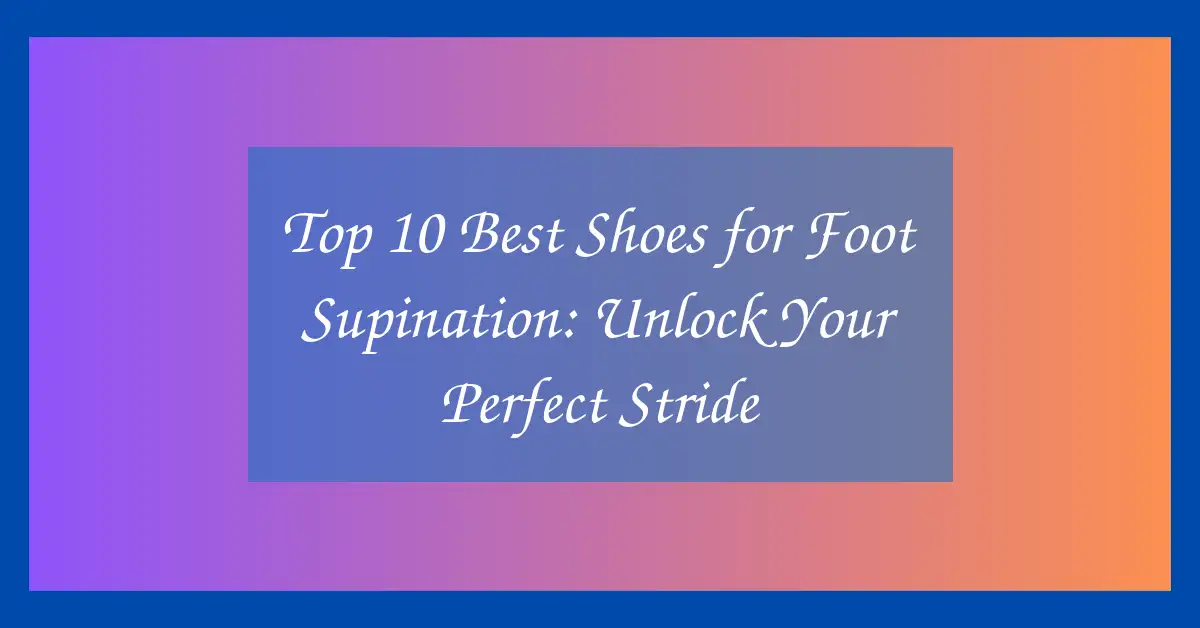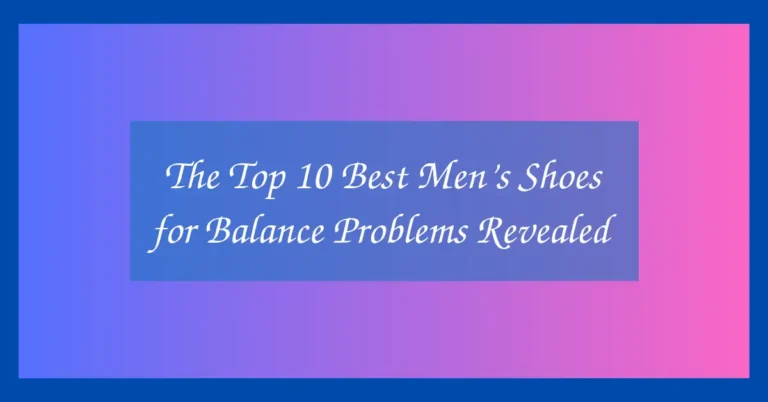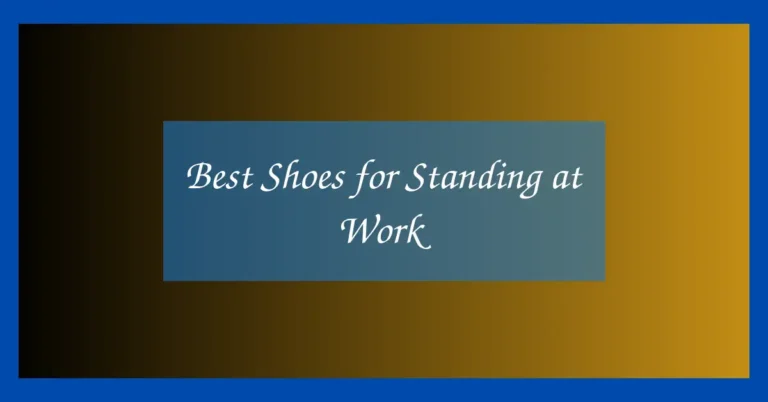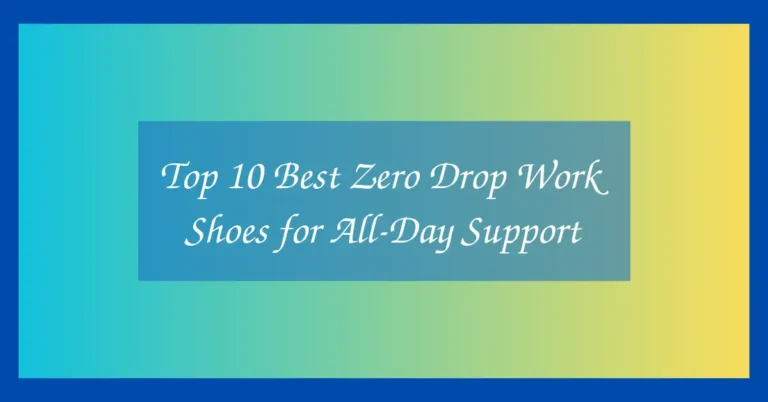Top 10 Best Shoes for Foot Supination: Unlock Your Perfect Stride
Finding the Best Shoes for Foot Supination can be life-changing for those who constantly deal with discomfort or injuries due to the way their feet roll outward while walking or running. Supination, or underpronation, requires special shoe features to correct gait and provide adequate support. Our expert-curated list ensures your next pair gives you the cushion, alignment, and stability you deserve.
From cushioned midsoles to reinforced arches and motion control features, this guide explores top-rated shoes specifically designed to combat supination. Whether you’re a runner, walker, or someone who needs all-day comfort, these picks are designed to reduce pain, improve posture, and prevent injury.
Best Shoes for Foot Supination
1. Brooks Ghost 15
The Brooks Ghost 15 is a neutral running shoe known for its soft cushioning and reliable comfort. It works exceptionally well for supinators who need impact protection and a smooth ride. The DNA LOFT v2 cushioning delivers a plush underfoot feel without being overly squishy.
It features a Segmented Crash Pad that adapts to each step, promoting better heel-to-toe transitions, especially helpful for those with underpronation. The breathable engineered mesh upper offers excellent fit and flexibility without sacrificing support.
The midsole structure ensures your foot doesn’t roll outward too far, which helps align your stride naturally. Ghost 15 is also lightweight and suited for both short jogs and long-distance running.
If you need a reliable everyday running shoe that keeps you pain-free and balanced, this is a top pick among neutral stability options for supination.
Pros
- Soft and responsive cushioning
- Great for long-distance running
- Breathable and supportive upper
Cons
- No wide-width options for all colors
- Not ideal for high-arched runners needing max support
2. ASICS Gel-Cumulus 25
The ASICS Gel-Cumulus 25 features updated PureGEL technology and FF BLAST PLUS cushioning that absorbs shock and adds bounce. This neutral trainer is ideal for supinators needing added softness during impact and takeoff.
Its plush midsole delivers adaptive comfort on hard surfaces while maintaining a lightweight profile. Supinators will benefit from its smooth transitions and moderate arch support that prevent rolling outward.
The engineered jacquard mesh upper hugs the foot for added security, reducing unnecessary foot movement. It also enhances breathability, making it ideal for warm-weather use.
For daily training or casual walks, the Gel-Cumulus 25 is a versatile option that supports natural foot motion without excessive stability features.
Pros
- Soft yet responsive cushioning
- Breathable mesh construction
- Improved heel-to-toe transitions
Cons
- Less structured for severe supination
- Upper may feel narrow for some
3. Saucony Ride 16
The Saucony Ride 16 combines comfort and responsiveness in a neutral design tailored for supinators. Its PWRRUN foam cushioning balances softness and energy return for a smoother ride.
It supports a natural gait cycle, offering supinators lightweight stability and comfort over extended runs. The midfoot contouring helps reduce pressure on the outer edge of the foot, where supinators often place excess weight.
The FORMFIT upper ensures an adaptive fit that holds the foot securely in place, preventing lateral roll. A breathable mesh build also improves airflow and reduces hot spots.
Its moderate drop and responsive cushioning make it a strong contender for daily training and long-mileage days. Perfect for neutral runners with slight underpronation.
Pros
- Balanced cushioning for supination
- Breathable and secure upper
- Durable outsole for daily runs
Cons
- May not suit high-mileage speed work
- Arch support is moderate
4. Nike Air Zoom Pegasus 40
The Nike Air Zoom Pegasus 40 offers a responsive and smooth ride, making it a reliable pick for supinators seeking cushioning and versatility. The forefoot and heel Zoom Air units add bounce where it matters most.
Its React foam midsole balances responsiveness and durability, ideal for maintaining stride control and reducing outward foot roll. The neutral support structure caters to supination without adding stiffness.
The redesigned upper uses an engineered mesh for breathability and improved fit across the midfoot and heel. This reduces unwanted motion and helps stabilize your gait.
Whether you’re jogging, sprinting, or walking, the Pegasus 40 adapts to various activities with ease. Supinators will especially benefit from its plush heel and midfoot fit.
Pros
- Zoom Air units add bounce
- Soft yet stable React midsole
- Flexible and breathable upper
Cons
- Not ideal for wide feet
- Minimal arch support
5. HOKA Clifton 9
HOKA Clifton 9 is renowned for its oversized cushioning and lightweight feel perfect for supinators who need shock absorption and smooth transitions. The high-stack EVA midsole minimizes impact forces on the outer edge of the foot.
Despite its large profile, it remains nimble and smooth underfoot. The early-stage Meta-Rocker enhances forward propulsion while controlling lateral roll, which supinators tend to experience.
The engineered knit upper ensures a snug yet breathable fit, reducing heel slippage and encouraging a consistent gait. Its wide base also promotes better balance and stability without intrusive support features.
Supinators looking for all-day comfort or recovery runs will love the Clifton 9’s cloud-like underfoot experience.
Pros
- Ultra-cushioned for shock absorption
- Meta-Rocker promotes smoother stride
- Wide platform enhances stability
Cons
- Chunky design may not appeal to all
- Limited ground feel
6. New Balance Fresh Foam X 880v13
The Fresh Foam X 880v13 from New Balance delivers plush cushioning and a stable ride, making it ideal for runners with supination. The dual-layer midsole uses Fresh Foam X for softness and a firmer foam underfoot for support.
This combination gives neutral runners controlled flexibility without forcing the foot inward. The structured heel counter offers secure lockdown and reduces lateral foot movement, helping with underpronation.
The engineered mesh upper is supportive and breathable, adapting to various foot shapes while maintaining a snug fit. It also improves overall balance and ground feel.
Designed for everyday use, this shoe blends comfort, durability, and cushioning for walking, running, or standing all day without causing foot fatigue.
Pros
- Soft yet supportive dual midsole
- Structured heel for foot control
- Breathable and durable upper
Cons
- Feels slightly stiff out of the box
- Heavier than some alternatives
7. Mizuno Wave Rider 27
The Mizuno Wave Rider 27 is a neutral running shoe offering wave plate technology that enhances shock absorption and energy return. It’s especially good for supinators needing lateral foot support without overcorrecting.
The MIZUNO ENERZY foam midsole creates a soft and responsive ride that reduces impact stress on the outer foot edge. The Wave Plate adds torsional rigidity and improves gait alignment for smoother transitions.
Its engineered mesh upper adjusts comfortably to foot shape and provides reliable breathability during extended activity. A padded collar and heel counter help keep the foot centered and aligned.
Ideal for runners looking for consistent daily mileage and a supportive, responsive underfoot feel without extra bulk.
Pros
- Wave Plate improves stability
- Durable yet responsive midsole
- Comfortable for long runs
Cons
- Break-in period needed
- Toe box may feel narrow
8. Altra Torin 7
Altra Torin 7 is a zero-drop, balanced-cushion shoe tailored for those who prefer a natural foot strike. Its FootShape toe box and high stack of Altra EGO MAX foam make it a solid choice for supinators seeking comfort and space.
The zero-drop design encourages midfoot landing, which helps distribute weight evenly and reduce stress on the outer foot. Supinators benefit from the roomy forefoot and balanced cushioning that promotes natural gait alignment.
The Torin 7’s updated tongue and heel collar enhance fit and comfort, while the upper improves airflow for warm-weather performance. Its wide platform adds a sense of groundedness on longer runs.
If you’re transitioning to a more natural ride with max cushioning, Torin 7 is an ideal pick for underpronators wanting room and support.
Pros
- Spacious FootShape toe box
- Zero-drop promotes even weight
- High-cushion EGO MAX foam
Cons
- Zero-drop takes adjustment
- Not suited for fast-paced running
9. On Cloudswift 3
The On Cloudswift 3 is engineered for urban runners needing support and cushion with a responsive underfoot feel. Its Helion superfoam and CloudTec elements absorb shock and ease supination-related discomfort.
The rocker-shaped sole promotes a fluid stride, especially for runners whose feet roll outward. Its integrated Speedboard provides energy return and foot stability, keeping the gait in alignment.
The engineered mesh upper ensures breathability while hugging the foot for midfoot security. A flexible heel fit and anatomical shape allow a snug yet forgiving fit.
For those navigating city streets or concrete paths, the Cloudswift 3 helps neutralize supination impact while maintaining a lightweight and agile profile.
Pros
- Helion foam cushions hard landings
- Speedboard aids smooth transitions
- Breathable and supportive upper
Cons
- Not ideal for trail terrain
- May run slightly narrow
10. Adidas Ultraboost Light
The Adidas Ultraboost Light combines comfort, bounce, and energy return with a lightweight feel. It’s ideal for supinators who want plush cushioning without sacrificing responsiveness.
Boost foam provides consistent rebound and impact protection for neutral runners who roll outward. The Light version improves weight distribution and transitions while keeping the foot centered through each stride.
The Primeknit upper conforms to your foot, offering flexibility and support. It adapts to movement while preventing unwanted lateral shifting a major plus for underpronators.
Whether for casual wear, walking, or daily running, the Ultraboost Light remains one of the most stylish and functional picks for foot supination support.
Pros
- Responsive Boost cushioning
- Lightweight and stylish
- Snug, adaptive Primeknit fit
Cons
- Less supportive arch for some
- May feel warm in summer
| Product Name | Cushioning Type | Upper Material | Best For | Support Feature |
|---|---|---|---|---|
| Brooks Ghost 15 | DNA LOFT v2 Foam | Engineered Mesh | Daily running | Segmented Crash Pad |
| ASICS Gel-Cumulus 25 | FF BLAST PLUS + PureGEL | Jacquard Mesh | Road training | Midfoot shock absorption |
| Saucony Ride 16 | PWRRUN Foam | FORMFIT Mesh | Neutral support | Midfoot contouring |
| Nike Pegasus 40 | React + Zoom Air | Engineered Mesh | Versatile workouts | Forefoot & heel bounce |
| HOKA Clifton 9 | High-stack EVA | Knit Upper | Recovery & comfort | Meta-Rocker stability |
| NB Fresh Foam X 880v13 | Fresh Foam X | Engineered Mesh | All-day wear | Heel lockdown structure |
| Mizuno Wave Rider 27 | ENERZY + Wave Plate | Mesh | Mid-distance running | Torsional stability |
| Altra Torin 7 | EGO MAX Foam | Engineered Mesh | Natural ride | Zero-drop platform |
| On Cloudswift 3 | Helion + CloudTec | Engineered Mesh | Urban runs | Rocker & Speedboard |
| Adidas Ultraboost Light | Boost Foam | Primeknit | Style + Performance | Lightweight motion control |
Best Shoes for Foot Supination Buying Guide
Cushioning Matters
For supinators, cushioning is essential to absorb shock on the outer edge of the foot. Look for plush or responsive foam midsoles like EVA, Boost, or Fresh Foam. These help reduce impact during heel strike and improve overall comfort without adding too much rigidity.
Neutral vs. Stability Shoes
Supinators typically benefit from neutral shoes rather than motion-control or stability models. Neutral shoes allow the foot to move more naturally while still providing enough structure to prevent over-rolling. Some designs, like rocker soles or crash pads, offer subtle correction without overcorrection.
Outsole Design & Flexibility
Outsole shape plays a role in guiding stride. Shoes with curved or slightly wider bases improve balance and reduce lateral movement. Flex grooves and rocker designs help maintain momentum and promote smoother transitions, especially for those with underpronation tendencies.
Upper Construction
A snug and supportive upper can prevent unwanted foot movement that exacerbates supination. Engineered mesh or Primeknit uppers balance structure and breathability. Reinforced heels or collars enhance stability without increasing weight.
Fit & Toe Box Room
Supinators often benefit from a wider toe box to allow natural toe splay and better balance. Look for shoes that offer anatomical fit or come in wide sizing if needed. Proper fit reduces the chance of rolling and provides more control during movement.
FAQ
What is foot supination and how do I know if I have it?
Foot supination, or underpronation, is when your weight rolls to the outer edges of your feet while walking or running. Signs include uneven wear on the outside of your shoes, frequent ankle sprains, and discomfort in knees or hips. A gait analysis can confirm if you’re a supinator.
Are neutral shoes better than stability shoes for supination?
Yes. Neutral shoes are generally better for supination because they allow natural foot movement without overcorrecting. Stability or motion-control shoes are designed for overpronation and may restrict the outward rolling needed for some supinators.
Do I need arch support if I supinate?
Most supinators have high arches, so moderate arch support can be beneficial. It’s important to choose shoes that balance support and cushioning without being too stiff. Some users may benefit from custom insoles for better arch alignment.
Can supination lead to injury?
Yes. Long-term supination without proper footwear can cause stress on the ankles, knees, hips, and lower back. It may lead to issues like plantar fasciitis, IT band syndrome, or shin splints if not addressed with the right shoes.
Should I replace my supination shoes frequently?
Absolutely. Because the outer edges wear faster, supinators may need to replace their shoes every 300 to 500 miles depending on usage and shoe type. Inspect the outsole regularly to avoid running on uneven wear patterns.
Is it okay to use running shoes for daily walking with supination?
Yes, running shoes often have better cushioning and support than casual walking shoes. Many neutral running shoes are suitable for all-day walking, especially if they offer flexibility, a wide base, and good impact protection for supinators.
Verdict
Choosing the best shoes for foot supination can significantly improve your comfort, posture, and joint health. Focus on models that offer soft cushioning, neutral support, and good fit. Whether you’re a runner or need everyday shoes, the right pair can help reduce pain, improve gait, and keep you injury-free in the long run.







